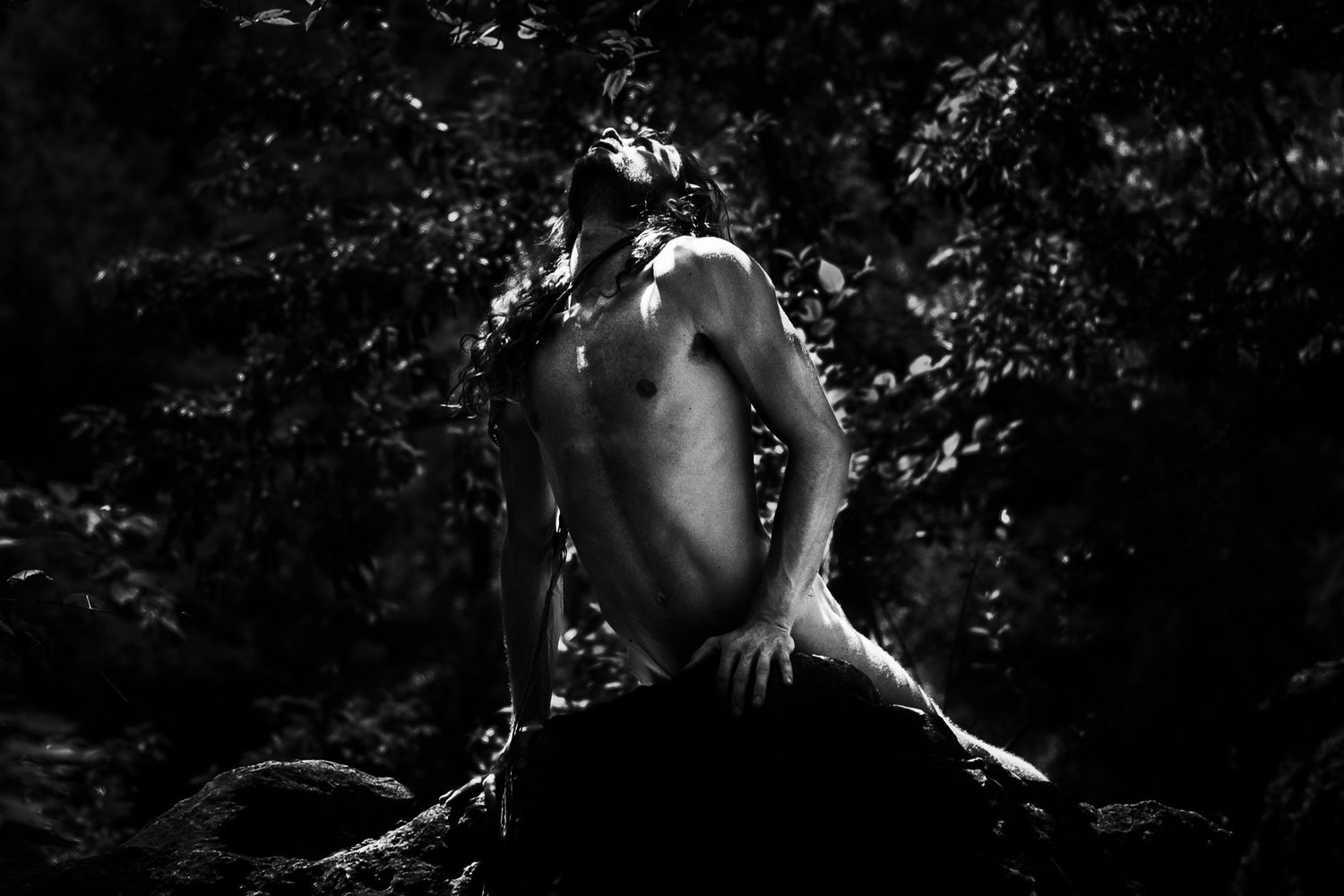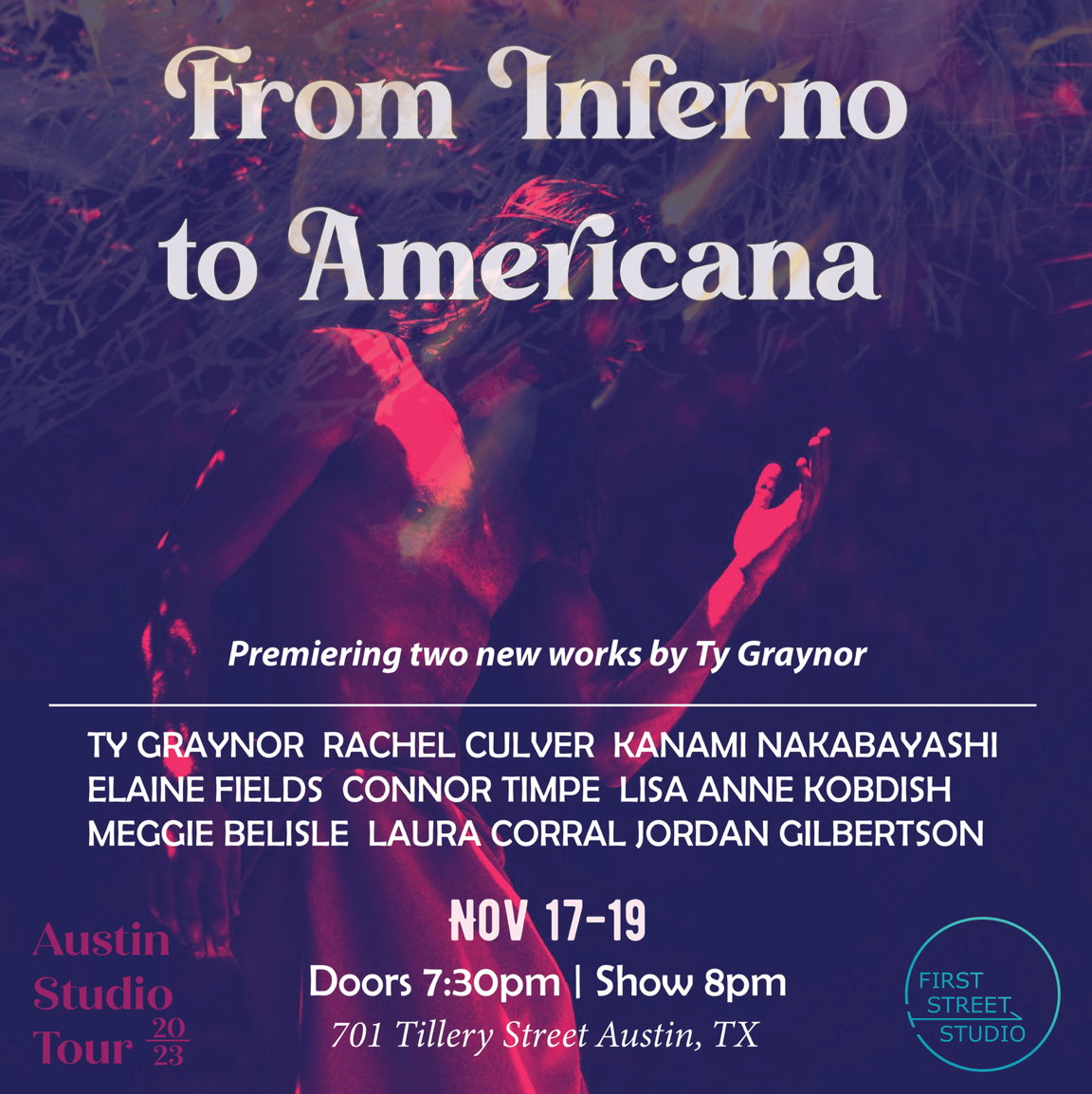Review: From Inferno to Americana by Ty Graynor
by David Glen Robinson
A figure lies in darkness upon a stage. He is nearly nude, clothed only in his humanity. Although fixed in stillness, the figure seems to writhe in deep, interior struggle.
Light fades up on the dancer, Everyman, in painful efforts to rise. He advances slowly upward in levels but struggle never ceases. We begin to recognize movements characteristic of modern/contemporary dance, but soon disciplined structures and movement tropes of modern ballet appear. The floorwork is abundant and perfectly executed. The dancer shows us several ways of entering and rising from shoulder rolls, and at the peak of the sequence of movements, he executes a flying but smooth cartwheel that lands silently. The dance clearly demonstrates mastery of movement and shape, but always with a drive to find more or to gain release. The dancer repeatedly reaches out with open hands or fists, receiving, grabbing, or clutching something from below, or within. His facial expressions follow his movement and build the strong emotionality of the piece.
A.J. Garcia-Rameau’s dramatic lighting adds immensely to mood and ambiance. Franz Liszt’s A Dante Symphony, S.109–1. Inferno on the soundtrack lays the groundwork and provides a clue to the meanings beneath the deep internal struggles the dancer illuminates in this piece entitled “Inferno.”

Ty Graynor is the choreographer and performer, and “Inferno” looms impressively as his signature solo. In literary dualism beloved by Western literary criticism, Graynor’s piece with its intense focus on the individual provides antithesis to Dante’s and the shade of Vergil’s descent into Hell in the Divine Comedy. “Inferno” is a grappling, arduous, desperate, reaching climb out of Hell, motivated and guided only by a grain of hope. As Graynor says in his program notes online: “The light I am capable of bestowing unto this world is only as strong and bold as the darkness I am able to carry.” “Inferno” lasted twenty minutes, ending in breathlessness, sweat, and deep contemplation. The sweat on Graynor was less than that on every member of the audience, each of us clutching something tiny to our hearts.
Ty Graynor arrived in Austin in 2022, not that long ago. Originally from New York, he seems to have been taking dance classes as soon as they brought him home from the hospital. He eventually gained a BFA in Dance Performance from the Hartt School at the University of Hartford. He advanced his training and curiosity of the world with residencies and workshops with modernist luminaries and their legacy companies. Most notable after his undergraduate work was his stay with the Martha Graham School of Contemporary Dance, where he joined Graham 2 (the second company of Martha Graham Dance Company). He danced lead roles in “Appalachian Spring,” “Acts of Light,” “Secular Games,” and “Diversion of Angels,” all rare gems of modern dance. After that stop he taught classes, mastered Limón technique, and performed in several well-known Limón works for the Jose Limón Dance Foundation. Additionally, he contributed to the creative processes of three new works commissioned by the foundation, one of which won a Bessie Award.
From 2019 until his 2022 arrival in Austin he received several creative teaching appointments. The time was also when the world fought back against the global pandemic. Graynor’s struggle saw him form the online Making Space Workshop, where he brought together teaching artists from an impressive array of dance organizations to share with students their knowledge of many movement disciplines. One of the important goals of the workshop was to overcome the social isolation and other ill effects of lockdowns. Students from all over the world participated.
This self-produced show at Austin’s First Street Studio, is entitled Inferno to Americana, the names of the two constituent pieces. “Inferno” led the show and the longish “Americana” ended it. The latter piece was structured in several sections choreographed by Graynor but performed by a coterie of professional dancers.
“Americana” is Graynor’s love song to America. Lesser talents quail at the continent’s mighty vistas, but those of the caliber of Ty Graynor know them innately as the homeland of their art. Graynor referred to artistic peregrinations through the country, noting that several sections of “Americana” were based on those journeys of body and mind. He urged us to view the sections as poems in movement. That refreshing take on viewing dance was not difficult to achieve.
“Americana” began with dancer Lisa Anne Kobdish moving slowly down the diagonal. She created an atmosphere of hopeful but questioning beginnings. Other dancers entered in choreographed fashion, and the section transitioned smoothly but clearly into the following sections.

Solos by the professional dancers, notably Rachel Cox Culver and Kanami Nakabayashi, were delivered with the confidence that comes with perfected technique and deep commitment to the dance and its choreography. Others in the cast were no less skilled and committed to the work. That level of intensity was well exemplified by Elaine Fields, a performer of diminutive physique and gracile sleekness. Her quick entrances and rapid running sections flashed past us with fawnlike grace; when Fields joined with another dancer or a forming group, her catlike power manifested. She lifted others with easy strength, and when elevated herself, she formed aerial shapes that helped her and the rest of the cast launch the entire show to higher levels of feeling and meaning.
Nobody really dances alone. Other cast members with generous showcase passages, if not outright solos, were Meggie Belisle, Jordan Gilberston, Laura Corral, and Connor Timpe. As the sole male in the piece, Tempe created a comical moment in which he was facing all the other dancers in a clump staring at him from along a long diagonal. The self-aware gender conflict commentary could not have been more obvious. The group began to move side-to-side like an advancing snake until they surrounded Timpe, and then the scene simply dissolved into another passage.
Overall, the diversity of movement in “Americana” was impressive, with plenty of floorwork, but not nearly as much as Graynor’s masterful use of the floor in “Inferno.” All choreography was fresh and inventive. This reviewer especially enjoyed the abstracted country dances taken from old country music playing on the soundtrack. A few of the passages were evocative of Jennifer Hart’s Performa/Dance Bluegrass Junction.
Another quality of the performance was its sharing and involvement with the audience, converting spectators into co-creators. Many times in the dance, a phrase or sequence would end far downstage. The dancer would make direct eye-contact with the audience, or at least the conventionally trained focus twelve inches above the heads of the audience. Graynor gestured directly to individual audience members more than once during “Inferno.” Affect followed focus, and the emotionality of the show and all its pieces flowed like shifting fragrances in keeping with the varied movement poems. Gone were the impassive, expressionless faces of the Merce Cunningham/John Cage era. Inferno to Americana’s intentional and purposeful violations of the fourth wall (that moss-bound rule of conventional theatre) appear to emanate from Graynor’s strong training and work in Limón technique and with Graham 2 company. The dancer is the whole—body, mind, and spirit. That includes the face and its expressions. The strength and emotionality of the dancers in “Americana” were seen best in the section (all the sections were unnamed but clearly delineated) performed to the old Union song “Solidarity Forever” sung by Pete Seeger. At times, inspired audience members clapped in tempo.
The show happily advances the new dance era of blended forms, amicable borrowings, and newer theatrical design ideas. And all of it is led by the revivified ballet form with its new ballets such as Ballet Austin II’s Maria and the Mouse Deer and Ventana Ballet’s annual serial The Watchmaker’s Song.
In his curtain speech before “Americana,” Graynor asked us in the audience comprised primarily of cognoscenti of the new dance community to undertake two tasks: open our eyes and open our hearts to the love being offered. Graynor and his fantastic colleagues made those tasks easy to accomplish.
From Inferno to Americana
by Ty Graynor
Ty Graynor
November 17 - November 19, 2023
